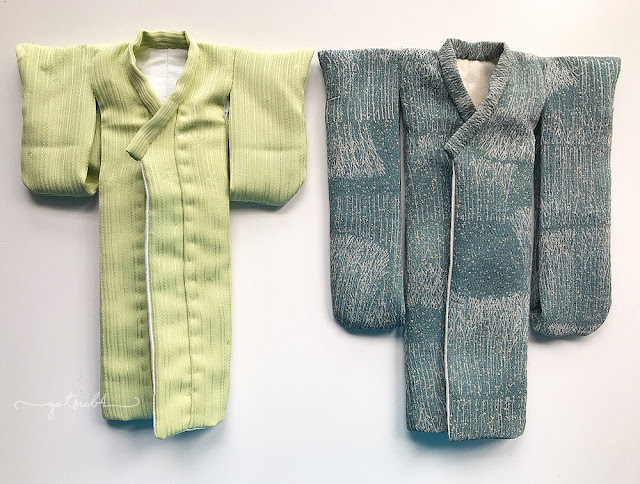Wakaba-iro Iromuji & Omeshicha Ogi Furisode (WIP)
 |
The recent New Year photo shoot with the girls made me think that it's time to get back to making Blythe kimono and yukata. It's been around 2-3 years since I last made one. Back then, I was mostly experimenting and used the pattern I drafted. Quite a lot has happened since then. And some time in 2015 or 2016 or early 2017 (can't remember precisely), I decided to buy the Doll Coordinate Recipe: Kimono book by chimachoco1 while at Radio Kaikan.
So, I went through my fabric stash and spent some time deciphering the Doll Coordinate Kimono book. And then got down to the business of sewing.... And thus completed 2 Blythe kimono.... Haven't gotten down to working on the obi and accessories to make up an entire ensemble. Yet.
Made one pale green iromuji and a teal furisode — for convenience, I'm calling them the Wakaba-iro Iromuji and Omeshicha Ogi Furisode respectively. Nothing poetic involved, just purely descriptive. I'm no Murasaki Shikibu.
They are both made from kimono scrap cloth, 100% silk. The cloth for the Wakaba-iro Iromuji I found while fabric shopping in Tsudanuma in September 2016, in a secondhand kimono store called Tansuya. It's figured silk, and shrunk a little along the warp after pre-wash treatment. The colour is one of my favourite shades of green. In the traditional Japanese colour system (dentouiro 伝統色), this shade is called wakaba-iro, which literally means "young leaves colour". (Surprisingly unpoetic!!!)
The cloth for the Omeshicha Ogi Furisode, also kimono scrap cloth, I bought on Etsy (seller KimonoYamamoto) in mid-2015. It is chirimen silk, which is obvious from the distinctive weave. Though I think, to be more precise, it is probably kinsha silk, since it is fine and light, and with crisp lines (vis-a-vis chirimen). Lovely teal colour called omeshicha (literally "silk crepe brown", but oddly not actually brown at all), with an all-over motif of grey silver grass (ogi, 荻) and dark yellow speckles.
 |
| Made with my own pattern (in Oct 2015) and made with chimachoco's pattern (IG) |
It's my first time using the Doll Coordinate Kimono pattern but I was relieved to see that my pattern doesn't differ in terms of construction, and only has slight differences in the measurements. That said, the book is fairly easy to use, as there are step-by-step diagrams to follow. Though, as usual, I did have to spend some time working out the Japanese instructions.
Made the Wakaba-iro Iromuji and Omeshicha Ogi Furisode with full lining (sans sleeve lining), but I only included the okumi in the iromuji. chimachoco-san's pattern omits the okumi and is only partially lined, which does make it much easier to sew (as she intended).
 |
| Fully lined. |
Fully lining the kimono body is quite a pain in the butt. Have to make the kimono body in duplicate (sans okumi), align all the seams and slip-stitch the miyatuskuchi area before attaching the collar. But I do like to hide the seam allowances, even though they're generally unseen....
Full lining also adds some thickness to the overall outfit, though I tried to minimise this by using lightweight fabrics — lawn for the iromuji and plain cotton for the furisode.
Now looking into my fabric stash for suitable colours to make the obi and accessories.... Having lots of fun here!!!
-------
1. Full title:「和のドールコーディネートレシピ 着物、小物作りから、へアアレンジまで」chimachocoちまちょこ(著), Dolly*Dolly Books, Graphics-sha (2013). Romaji: Wa no dorukodineto reshipi kimono, komono tsukuri kara, hea arenji made (trans. "Japanese Doll Coordinate Recipe -From Kimono, Accessories to Hair Arrangement-") (See Amazon.com).

Comments
Post a Comment
Thank you for stopping by. I would love to hear from you, and I believe it is important to have a respectful and open-minded environment in which to express our views. Different views are welcome; abuse, hate speech and cyberbullying are not. Freedom of speech does not justify the unacceptable.